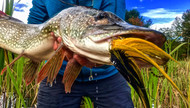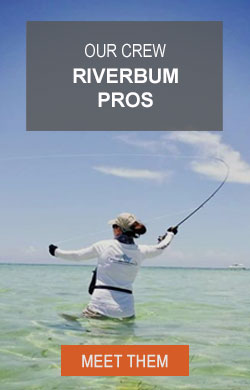What Makes A Predator Fly A Predator Fly?
Predator flies are not built the same as other big game species flies.
Predator tying style was borrowed from saltwater tyer Bob Popovics with regards to the application of bucktail, but musky and pike flies took that technique and veered towards a denser fly direction.
Predator Flies 101
At first, the early predator flies were super packed with bucktail and felt like a wool sock when casting. Today's predator flies are more minimalistic and made for the convenience of casting.
The art is to balance enough material on the shank to cast the illusion that it's a really plump baitfish even though it’s not.
The “Profile Shot”
The predator style of applying bucktail creates rings of what look like miniature drink umbrellas that stack together.
Now, imagine those umbrellas only folding slightly under pressure when stripped through the water, but as soon as the movement stops the mini umbrellas of bucktail pop out into full umbrella form and this engineering helps turn the fly sideways for what's referred to as the “profile shot” or full side view which predators find tantalizing as they much prefer to T-bone their prey.
This profile shot on each pause of your retrieve gives your fly many T-bone opportunities, which predators adore. This action is what makes a predator fly a predator fly. Predators love easy weak prey. That's how they stay on top of the food chain.
Feathers tied in the reverse prayer method also help to aid with the profile shot retrieving action along with Buford heads, foam heads, keel weight, and even foam sections secreted in the body of a predator fly.
Engineered For Movement
All of this engineering is created for intentional movement unlike most saltwater or other big game flies which usually go in a straight line from your furthest cast back to the angler. Besides the profile shot, predator flies can also sinuate when retrieved, and dive/hover with an aggressive sink-tip.
All fish-eating fish love predator fly action, fresh or salt.
In fact, many saltwater anglers are starting to use predator flies for stripers and love the hot response they get from stripers.
Other Characteristics Of A Predator Fly
Besides the engineering of materials for movement, the other components that separate predator flies are articulated shanks which provide more movement paired with large gap hooks for easier hook-sets with big fish.
Large gap hooks typically start with 3/0 for 6’ flies up to multiple 8/0 hooks for a 12” fly.
At times of the year when the bait is migrating, smaller flies will outpace larger flies for any size musky or pike. However, during non-migration periods, bigger flies are typically the better option.
To understand when is best for what size or species of bait it's best to get to know your intended waters and learn the migrational patterns of the baitfish population. Typically there is a spring and fall migration. With longer times of the year spent at the winter and summer grounds. Just like the apex of all predators: sharks, predators are never far from their food source. Getting to know and understand your queries' food migration patterns will increase your catching odds exponentially.
Tight Lines,
Nome Stark
Photos credit @PredatorsOnTheFly







